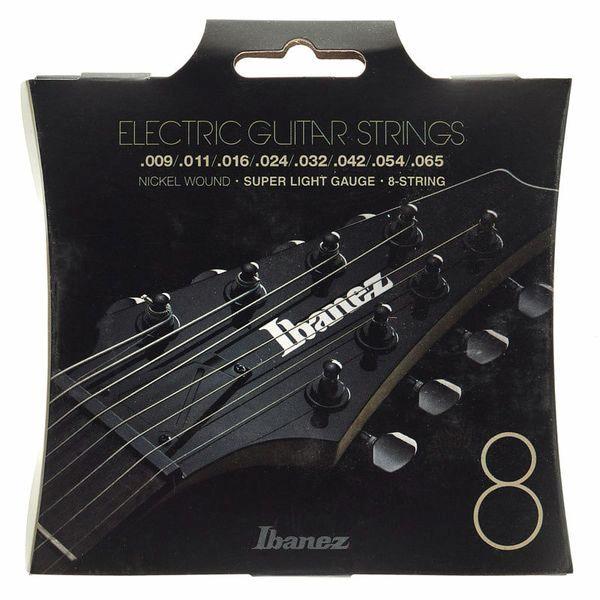Have you ever felt the ground shake under your feet as you strike a chord on your guitar? The sensation is almost tangible when you’re wielding an 8-string beast with its jaw-dropping range and power. It was a moment like this that sparked a seismic shift in my musical journey, but I’ll come back to that retrospectively.
In our world of dynamic polyphonic expressions, the 8-string guitar has emerged as a remarkable tool. However, this vast landscape of potential isn’t traversable with just any old strings. They need to be extended range guitar strings, thoughtfully chosen and set, to unveil the beasts’ full sonic scope. Whether you’re a seasoned 8-string aficionado or just flirting with the extended range concept, understanding what makes these strings tick can be the key that unlocks a new dimension to your riffs.
Drawing from my extensive research and hands-on experience in the craft of lutherie, I’ve come to not just cognitively understand, but truly appreciate the multifaceted world of 8-string guitar strings. The profound mystery that ensued from that groundbreaking chord led me down a labyrinth of string gauges, materials, tensions and more. So together, let’s dive into this musical rabbit hole, and navigate the nitty-gritty of these extended range harmonics.
Understanding 8-String Guitar Strings
Gauge and Tension

From numerous experiments and experiences, I’ve learned that the key concepts to understand when dealing with 8-string guitar strings are guitar string gauge and guitar string tension. Remember, they are interconnected variables that greatly affect your instrument’s functionality, sound, and playability. The string gauge refers to its thickness and is measured in thousandths of an inch. The thicker the string, the lower its pitch tends to be.
String tension, on the other hand, directly influences your playing comfort and the string’s pitch. Higher tension increases pitch and requires more force to play, while lower tension does the opposite. Through a careful interplay, forming a balanced tension profile for each string is crucial.
When selecting 8-string guitar strings, achieving the right balance between these two factors can be an art. A small variation in gauge or tension can dramatically influence your instrument’s sound, playability, and overall performance. It is this balancing act that has shaped my understanding and continues to drive my in-depth exploration of 8-string guitar strings.
As we traverse deeper into the realm of 8-string guitars in the following sections, you’ll see how this understanding of gauge and tension plays into different aspects such as string materials, genre-specific preferences, and string lifespan optimization strategies.
Material Types

Recognizing the various types of materials used in the production of 8-string guitar strings significantly expands your understanding of their characteristics and potential sound outputs. A broad choice of different materials results in a myriad of tonal options, enabling you to fine-tune your instrument according to your preferences.
As a luthier, my experiences with nickel wound strings have taught me their inherent brightness and rich sustain, which lends itself to many genres of music. These strings produce a classic, balanced tone, adapting well to both clean and distorted channels.
On the other hand, my experiments with hexagonal steel core strings have revealed their unique properties. The hexagonal core leads to a tighter feel and enhanced dynamic response, offering great clarity and a sharp, brighter tone. This makes them a favorite for aggressive, percussive styles.
Understanding the materials in your string choice influences the sonic texture and playability of your guitar, contributing towards the goal of achieving your sound ideal. As you move further in your exploration of 8-string guitar strings, remember that every material type imparts a specific character to your sound, requiring a discerning ear and experience to harness.
Best 8-String Guitar Strings Available
Optimal Strings for Different Genres

Having dabbled with various musical styles over the course of my guitar playing career, I’ve discovered how much the genre of music can influence the choice of guitar strings. This has led me to understand the importance of optimal guitar strings for different genres within the realm of 8-string guitars.
Take metal music, for instance. The low, aggressive riffs, matched with the high, screeching solos, demand a set of guitar strings that can withstand extreme tension. For this genre, you can’t go wrong with heavy gauge strings. Namely, heavy bottom light gauge strings are ideal, as they have the durability to withstand the high-velocity licks and riffs associated with metal music.
Another genre that incorporates 8-string guitars quite heavily is djent. Known for its complex, syncopated rhythms and expansive range, it requires strings that provide clear and defined low-end tones, without compromising the bright and cutting presence of the higher strings. Optimal guitar strings for djent are often medium gauge – neither too heavy nor too light. This helps to maintain the distinctive tone and balance characteristic of this genre.
While these are effective rules of thumb, the ideal string choice would vary for each guitar player, based on their unique playing style and tonal preference. What sounds perfect to one person might not to another. Hence, experimentation is key in finding your perfect match.
Remember, your string choice can both widen your tonal palette and enhance your playing comfort. Thus, understanding the correlation between string type and music genre can steer your decision in the right direction, helping you extract the best performance from your 8-string guitar.
Next, we’ll delve into the optimized strings for tuning types, another crucial aspect that can significantly influence your decision when selecting the best 8-string guitar strings.
Optimized Strings for Tuning Types

In our quest for the best 8-string guitar strings available, we must not overlook the crucial role of optimized strings for specific tuning types. Maximizing your instrument’s potential often requires experimentation with different string tension settings. This wisdom is not just from my personal odyssey with my 8-string beast, but also backed by the experiences of fellow luthiers and learned tips from countless music publications.
Understanding optimal gauges for drop tuning, for instance, can enhance your guitar’s responsiveness and playability. Lower tunings require heavier gauges to maintain tension, making it essential to strike a balance that doesn’t compromise the guitar’s intonation or setup. A case in point is the Strandberg optimized tension set, designed to retain perfectly balanced tension across all pitches, thus promoting greater stability for your extended range instrument.
Recognizing the pairing between specific string types and tunings not only grants reliability in tuning stability, but can shape your unique sound, making it a key factor in tailoring your guitar to your musical vision. As we delve deeper into other genre-specific string needs, remember that optimized strings for various tunings herald a new level of guitar personalization. This extends the horizons of our musical expression and assists us in mastering our 8-string craft.
Making Your Strings Last Longer

In a luthier’s world, every string matters. I’ve learnt that prolonging the longevity of strings can make a huge difference in both tone quality and economic savings. My journey of becoming an experienced luthier has been an enriching blend of personal habits and professional observations. In my quest to describe the world of 8-string guitar strings, I believe sharing practical tips on string longevity is essential.
How would you like to discover some luthier secrets to string longevity that could save you time and money while enhancing your guitar’s tone? Brace yourselves, as I dive deep into sharing what I’ve accrued over years of fine-tuning these diverse instruments.
A major key lies in routine string maintenance post-playing sessions. Carefully wiping down your strings after each play can remove sweat and oils that speed up corrosion. Consider using cleaning products designed specifically for guitar strings, where a few drops can further prolong your string’s life.
Sometimes, the way you play the guitar influences string longevity. Strumming or plucking too hard can put excessive strain on your strings, reducing their lifespan. Thus, learning to control the intensity of your play can contribute significantly to extended string life.
Furthermore, old strings lose their brightness and tone. Habitual retuning of old strings strains them, leading to quicker breakage. Consequentially, changes in ambient conditions and regular tuning stability checks form a proactive routine to ensure optimal string health.
In my experience, changing one string at a time during maintenance minimizes the tension shifts on the neck, helping maintain the guitar’s setup and promoting string longevity.
Lastly, string longevity does not mean compromising on quality or optimum performance. I can tell you from years of playing and observing, it’s better to change to a fresh string set when necessary. The sweet balance lies in understanding when to elongate the usage and when to replace for maximum musical benefits.
In the upcoming section, we’ll delve into some frequently asked questions about 8-string guitar strings. After all, knowledge and understanding are your finest tools in the journey of guitar mastery.
FAQs
What are 8-string guitar strings?
What varieties of 8-string guitar strings are available?
What features should I look for in 8-string guitar strings?
Do you have any tips for buying 8-string guitar strings?
Conclusion
In the spirit of lutherie, our journey through the world of 8-string guitar strings has been as fascinating as it is insightful. We’ve unraveled nuances about gauge, tension, material types, and so much more. All to enhance your own musical journey.
How can this journey into 8-string guitar strings shape and transform your own guitar adventure? It’s simple. Quality strings paired with knowledge equates to mastery. Whether you’re chasing the heavy beats of metal or the smooth melodies of jazz, the choice of strings can make all the difference!
Investing in the right strings is a way of investing in your passion. Don’t skimp on them, and don’t hesitate to experiment. Each string you try can lead to becoming a better guitarist.
Tap into the beautiful world of 8-string guitar strings. Your guitar, your adventure!
